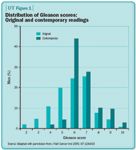Article
How to interpret Gleason score in contemporary biopsy
Urologists counseling men with newly diagnosed prostate canceroften assess the risk posed by the disease in order to recommend anappropriate treatment strategy. During the past decade, clinicianshave recognized that men with elevated PSA levels have asignificant chance of harboring extracapsular disease. Anotherindicator of potentially advanced disease is the number of biopsycores that are positive for disease and the percentage of each corethat contains disease.

Pathologists have long known that tissue histology carries significant prognostic information. A.C. Broders, MD (Minn Med 1925; 8:726-30) was one of the first pathologists to classify neoplasia according to histology criteria. As pathologists became more familiar with prostate cancer, several classification schemes, many unique to the treating institution, were developed. The Johns Hopkins Hospital and the Mayo Clinic, for example, used systems developed by their own institution for grading prostate cancer.
Gleason classification scheme



Current challenges
Contemporary prostate biopsies offer a much greater challenge. Pathologists have minimal quantities of tissue to evaluate and frequently must make a diagnosis of prostate cancer based on a single cluster of glandular tissue. Not infrequently, the entire specimen consists of a single, small focus of prostate cancer, which the pathologist reluctantly calls either 3+3 disease or 4+4 disease. The two numbers do not reflect an assessment of different areas within the specimen, but are simply an artifact of the classification system.
Urologists rarely see Gleason patterns 2 through 5 in contemporary urology practice. Have these cancers vanished, or have pathologists changed their reference standards?
To address this problem, our group located pathology biopsy slides on 1,858 men living in Connecticut who were diagnosed with prostate cancer during the period 1990 to 1992. We asked an experienced pathologist who had worked extensively with Dr. Gleason to re-read these specimens in 2004 and 2005. We then compared the historical readings with the contemporary readings.
















